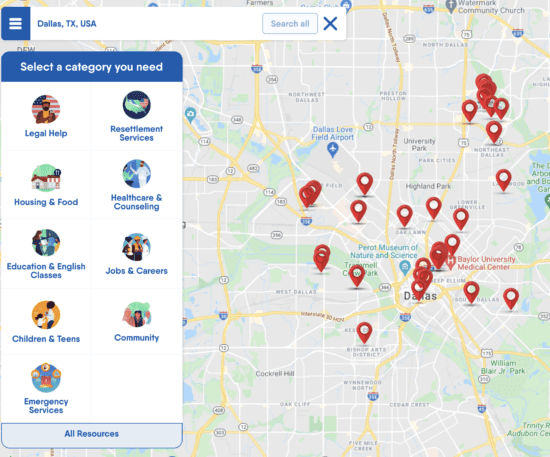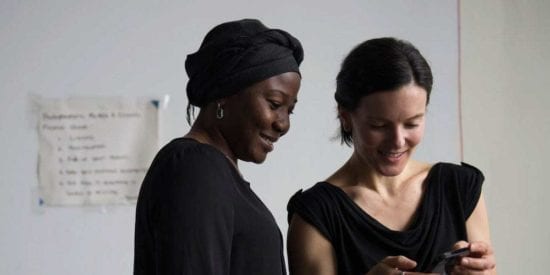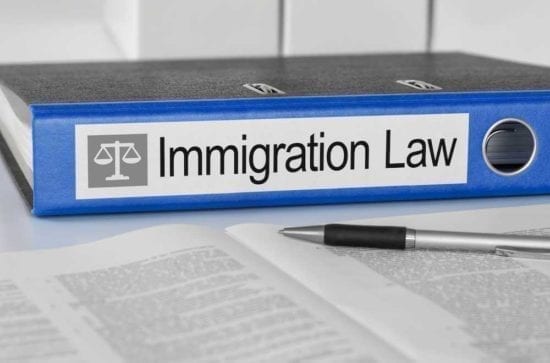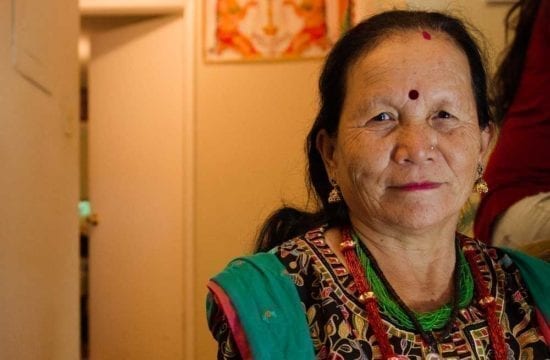Sự đa dạng là gì?
Sự đa dạng là sự phong phú của nhiều người, nhiều sự vật hoặc nhiều ý tưởng khác nhau. Khi chúng ta nói về sự đa dạng ở Hoa Kỳ, chúng ta thường nói về con người và các chủng tộc khác nhau. Nó cũng có thể bao gồm các nhóm khác như dân tộc, tôn giáo, khuynh hướng tình dục, giới tính, khả năng và độ tuổi.
Không chỉ có sự khác biệt. Nó cũng có thể nói về cách những khác biệt mang lại lợi ích cho cộng đồng. Công bằng và hòa nhập là những điều quan trọng cần nghĩ đến khi nói đến sự đa dạng.
Công bằng là khi tất cả mọi người đều nhận được những gì họ cần để được đối xử công bằng. Để mọi thứ được công bằng, một số nhóm người cần nhiều sự giúp đỡ hơn những nhóm khác.
Công bằng không giống với bình đẳng. Bình đẳng là khi mọi người đều có cơ hội như nhau.
Hòa nhập có nghĩa là bao gồm những người từ các nhóm khác nhau và trao cho họ cơ hội. Điều này cũng có nghĩa là tôn trọng và đánh giá cao kinh nghiệm và đóng góp của họ. Điều này rất quan trọng đối với những người thường bị loại trừ. Ý kiến của họ rất có giá trị trong các cuộc thảo luận và ra quyết định của cộng đồng.
Nghiên cứu cho thấy nơi làm việc đa dạng sẽ sáng tạo và đổi mới hơn. Họ cũng giỏi hơn trong việc đưa ra quyết định.
Chủng tộc
Chủng tộc là thứ do xã hội tạo ra để phân chia con người thành các nhóm chủ yếu dựa trên đặc điểm ngoại hình. Người da trắng chiếm đa số ở Hoa Kỳ. Những người thuộc các chủng tộc khác ngoài người da trắng thường được gọi là “dân tộc thiểu số”.
Dựa trên Điều tra dân số năm 2021, dân số USA là:
- 59,3% là người da trắng và không phải người gốc Tây Ban Nha hoặc La tinh
- 18,9% người gốc Tây Ban Nha hoặc La tinh
- 13,6% Người da đen hoặc người Mỹ gốc Phi
- 6,1% người Châu Á
- 2,9% Hai hoặc nhiều chủng tộc
- 1,3% Người Mỹ bản địa và Người bản địa Alaska
- 0,3% Người Hawaii bản địa và Người dân đảo Thái Bình Dương khác
Hoa Kỳ hiện đang đa dạng hơn bao giờ hết. Người da đen chiếm đa số ở một số vùng phía Nam. Người gốc Tây Ban Nha chiếm đa số ở một số vùng Tây Nam và Tây.
Các biểu mẫu của chính phủ thường hỏi về chủng tộc. Thông tin này giúp đảm bảo các dịch vụ đáp ứng được nhu cầu của các nhóm khác nhau.
Phân biệt chủng tộc và kỳ thị
Phân biệt chủng tộc và kỳ thị là một phần thường trực trong cuộc sống của nhiều người dân ở USA. Phân biệt đối xử là khi một người bị đối xử bất công vì họ thuộc một nhóm nào đó. Phân biệt chủng tộc là khi cách đối xử này xảy ra vì lý do chủng tộc của họ.
Phân biệt đối xử với ai đó vì lý do:
- Độ tuổi
- Tình trạng khuyết tật
- Nguồn gốc quốc gia
- Chủng tộc và màu da
- Tôn giáo hoặc tín ngưỡng
- Bản dạng giới tính hoặc khuynh hướng tình dục
Bạn có thể giúp ngăn chặn nạn phân biệt chủng tộc bằng cách tìm hiểu về kinh nghiệm của người khác. Hãy lắng nghe họ và cố gắng hiểu xem họ cảm thấy thế nào. Chia sẻ kinh nghiệm của bạn về vấn đề phân biệt chủng tộc. Hãy lên tiếng nếu ai đó nói hoặc làm điều gì đó mang tính phân biệt chủng tộc. Báo cáo hành vi phân biệt đối xử.
| Chủng tộc và dân tộc không giống nhau. Dân tộc là sự khác biệt giữa con người do ngôn ngữ và văn hóa. Nó dựa trên nơi bạn sống hoặc nền văn hóa bạn chia sẻ với người khác. Dân tộc thường do mỗi người lựa chọn. |
Văn hoá
Những người nhập cư từ khắp nơi trên thế giới đã đến Hoa Kỳ kể từ thế kỷ 17. Có những người thuộc nhiều dân tộc khác nhau, với nhiều nền văn hóa và ngôn ngữ khác nhau. Người Mexico, tiếng Trung, Ấn Độ và Philippines là những nhóm dân tộc đông nhất.
Nhiều người Mỹ có lối sống và giá trị chung tương tự nhau. Nhưng không phải ai cũng cư xử hoặc suy nghĩ giống nhau. Có nhiều nền văn hóa khác nhau ảnh hưởng đến lối sống của con người. Có những nền văn hóa từ bên ngoài USA cũng như những nền văn hóa từ các vùng khác nhau trong nước.
Tìm danh sách hữu ích về những khác biệt văn hóa ở USA.
Không có ngôn ngữ chính thức ở USA. Tiếng Anh là ngôn ngữ được sử dụng rộng rãi nhất nhưng vẫn còn nhiều ngôn ngữ khác được nói. Trong đó có hơn 41 triệu người nói tiếng Tây Ban Nha và 3,5 triệu người nói tiếng Trung Quốc. Có hơn 1 triệu người nói tiếng Việt, tiếng Ả Rập, tiếng Pháp và tiếng Hàn.
Tôn giáo
Phần lớn người dân ở USA tự nhận mình là người theo đạo Thiên chúa. Tiếp theo là những người theo Do Thái giáo, Ấn Độ giáo, Phật giáo và Hồi giáo. Trong vài năm trở lại đây, số lượng người không theo tôn giáo nào cũng tăng lên.
Ở Hoa Kỳ có quyền tự do tôn giáo. Bạn có thể thực hành bất kỳ tôn giáo nào bạn muốn. Chính phủ không áp đặt một niềm tin cụ thể nào. Mọi người theo nhiều tôn giáo khác nhau và điều này đã ảnh hưởng đến Văn hóa Mỹ và truyền thống của người Mỹ.
Điều quan trọng là cộng đồng tôn giáo đa dạng của chúng ta có cơ hội thực hành tự do, chẳng hạn như tạo cho người Hồi giáo một nơi để cầu nguyện tại nơi làm việc hoặc trường học.
Khuynh hướng tình dục và giới tính
Luật liên bang Hoa Kỳ bảo vệ mọi người khỏi sự phân biệt đối xử dựa trên khuynh hướng tình dục và giới tính.
Cộng đồng LGBTQ+
LGBTQ+ là viết tắt của đồng tính nữ, đồng tính nam, song tính, chuyển giới (trans) và kỳ quặc. Dấu cộng “+” dành cho các bản dạng tình dục và bản dạng giới khác. 7,1% người dân Hoa Kỳ tự nhận mình là LGBTQ+.
Mức độ chấp nhận sự đa dạng của cộng đồng LGBTQ+ rất khác nhau. Điều này phụ thuộc vào vị trí, văn hóa và hoàn cảnh của mỗi cá nhân. Trên khắp cả nước, hôn nhân đồng giới là hợp pháp và cộng đồng LGBTQ+ của chúng tôi được tôn vinh vào tháng 6 hàng năm trong Tháng Tự hào.
Tìm hiểu thêm về quyền của LGBTQ+.
Giới tính
Sự đa dạng về giới tính thường liên quan đến sự khác biệt giữa nam giới và nữ giới, còn được gọi là “khoảng cách giới tính”. Ví dụ, nam giới được trao nhiều cơ hội hơn trong sự nghiệp. Một số nơi làm việc và công việc chủ yếu là nam giới.
Sự đa dạng về giới cũng thừa nhận và tôn trọng những cách nhận dạng khác. Một số người không xác định mình là đàn ông hay phụ nữ. Những người khác không xác định được giới tính mà họ được chỉ định khi sinh ra. Điều quan trọng là phải sử dụng tên và đại từ mà người đó thích.
Khả năng
Sự đa dạng về năng lực đề cập đến những khả năng và khuyết tật khác nhau. Mỗi người có kỹ năng khác nhau. Khả năng có thể khác nhau tùy thuộc vào khả năng tiếp cận giáo dục và các nguồn lực khác của mỗi người.
Khuyết tật là tình trạng của cơ thể hoặc tâm trí khiến việc thực hiện một số hoạt động trở nên khó khăn hơn. Chúng có thể ảnh hưởng đến thị lực, khả năng vận động, khả năng học tập, giao tiếp, thính giác và nhiều chức năng khác của một người. Nó có thể thay đổi cách một người tương tác với thế giới xung quanh. 12,7% dân số Hoa Kỳ bị khuyết tật.
Đạo luật Người khuyết tật Hoa Kỳ (ADA) đã phá bỏ nhiều rào cản. Luật này nghiêm cấm hành vi phân biệt đối xử với người khuyết tật trong việc làm và giao thông. ADA cấm phân biệt đối xử trong việc tiếp cận các chương trình và dịch vụ của chính quyền tiểu bang và địa phương.
Độ tuổi
Sự đa dạng về độ tuổi là sự chấp nhận những người có độ tuổi khác nhau tại nơi làm việc. Đạo luật chống phân biệt đối xử về tuổi tác trong việc làm sẽ bảo vệ những người lao động trên 40 tuổi nhưng những người lao động lớn tuổi vẫn báo cáo rằng họ bị đối xử không bình đẳng.
Người cao tuổi cũng không được tôn trọng như ở nhiều quốc gia khác. Ý kiến đóng góp của họ trong các quyết định không phải lúc nào cũng được coi trọng hoặc mong muốn.
Khi dân số Hoa Kỳ già đi, đất nước này cũng trở nên đa dạng hơn. Người cao tuổi có sự đa dạng về chủng tộc hơn. Nhóm dân số này phải đối mặt với những thách thức như khó khăn về kinh tế, chăm sóc y tế và sự cô đơn.
Tìm tài nguyên hữu ích cho người cao tuổi.
| Sự đa dạng là điều đáng được tôn vinh. Bao gồm cả những người khác biệt với bạn. Hãy lắng nghe những câu chuyện và trải nghiệm của họ. Chia sẻ của riêng bạn. Hãy trân trọng những điều độc đáo mà mỗi chúng ta có thể mang lại, đặc biệt là cộng đồng người nhập cư của chúng ta! |

Tìm trợ giúp pháp lý, lớp học tiếng Anh, phòng khám sức khỏe, hỗ trợ nhà ở, v.v. Tìm kiếm bản đồ địa phương và danh sách các dịch vụ cho người nhập cư ở Hoa Kỳ bằng ứng dụng FindHello.
Chúng tôi mong muốn cung cấp thông tin dễ hiểu được cập nhật thường xuyên. Thông tin này không phải là lời khuyên pháp lý.



